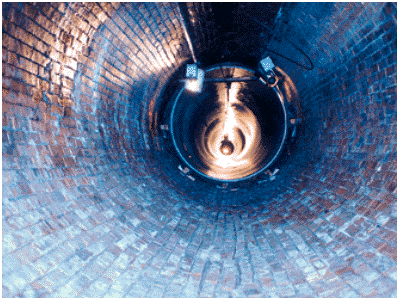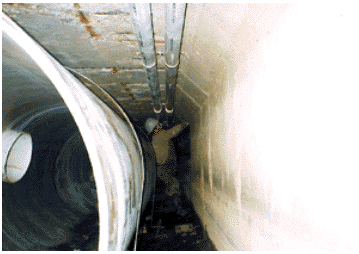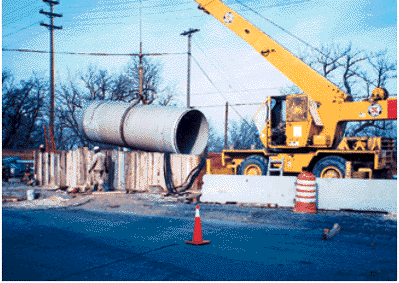Large Diameter Pipe Solves Three Cleveland Sewer Problems
Three separate Cleveland-area agencies installed large diameter centrifugal-cast fiberglass-reinforced polymer mortar (CCFRPM) pipes to rehabilitate their sewers. Each of the three projects faced multiple challenges and provided interesting solutions, and demonstrated the viability and cost effectiveness of the slip-lining renewal of sewers.
Realigning the Westerly Interceptor
The Westerly Interceptor of the Northeast Ohio Regional Sanitary District was so irregular in grade and alignment that installer, Kenmor Construction of Akron, OH had to by-pass the flow to properly survey the conditions and determine the maximum liner diameter.
Ultimately, the existing 1,600 ft of 90-in. and 81-in. brick sewers were lined with 78 in. and 66 in. respectively, of CCFRPM pipe, manufactured by Hobas Pipe, of Houston, TX.

These 78-in. pipes blocked in the brick Westerly sewer to improve line and grade.
Sufficient flow capacity was maintained thanks to the pipe's hydraulics and by removing the sags.
To improve the system straightness, the pipes were slid in one at a time on pre-set rails and blocked in place. Assembling the flush profile gasket-sealed joints was simple because the constant OD pipe surface assured precise alignment of the liners. Annulus grouting in three lifts with 60-pcf material completed the successful renewal of these up to 25-ft deep lines.
Reinforcing a Box Culvert at the Proposed Cleveland Browns Stadium Site
Since an existing 5 x 8 ft concrete box culvert crossed under the new Cleveland Browns stadium site at the proposed 50-yard line, permanent reinforcement and corrosion protection of the drain were necessary.
Design engineer, Dodson-Stilson of Cleveland, chose 54-in. Hobas CCFRPM pipes with flush gasket-sealed joints to tackle the 900-ft long lining project.

Workers install a 54-in. liner with 18-in. laterals in the box tunnel under the new Browns stadium.
The 57-in. OD pipes were cabled in, one at a time, on wooden runners by Kassouf Construction of Cleveland, the subcontractor to general contractor Independence Excavating of Independence.
The mostly 20-ft long liner pipes were strapped in place on 10-ft centers to fix their position. Six 18-in. laterals were connected; four using Inserta-tee fittings and two by lamination techniques. Long-term structural stability was provided by filling the annulus with a 55-pcf density grout placed in three lifts.
Railroad Saved
In a project to rehabilitate a sagging brick sewer buried with shallow cover under an active railroad in the City of Cleveland, engineers Michael Benza & Associates of Brecksville specified Hobas' CCFRPM pipes.
The 66-in. CD liner pipes with flush, gasket-sealed joints, were inserted into the distorted 78-in. existing line on wooden runners and blocked in place by Triad Engineering & Contracting of Walton Hills, subcontractor to Lott Construction of S. Euclid.

Twenty-foot section on 78-in. pipe are lifted and lowered into place in Cleveland.
To assure adequate crown strength to support an E80 railroad load with only 5 ft of cover, a pipe stiffness of 144 psi was designed for the new liner. To achieve a tight installation, the annulus was grouted with 65-pcf material placed in two lifts.
While these projects were relatively small in scope, their difficulty and impact on the Cleveland area was not.
For more information on the Hobas Pipe large diameter, centrifugal-cast, fiberglass-reinforced polymer mortar pipe described here, contact the company at 1413 E. Richey Road, Houston TX 77073; phone 281-821-2200; fax 281-821-7715.
Edited by Tracy Fabre
